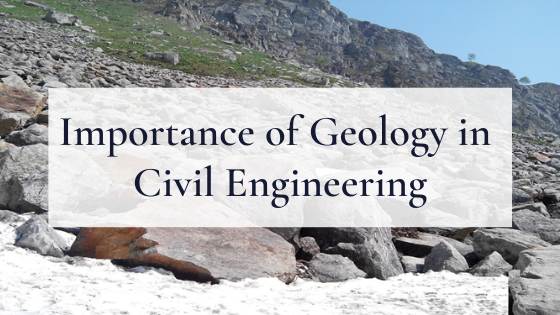The Only Guide to Geotechnical Engineering For Construction Projects
The Only Guide to Geotechnical Engineering For Construction Projects
Blog Article
Facts About Geotechnical Engineering For Construction Projects Uncovered
Table of ContentsNot known Factual Statements About Geotechnical Engineering For Construction Projects Geotechnical Engineering For Construction Projects for DummiesThe 3-Minute Rule for Geotechnical Engineering For Construction ProjectsThe 2-Minute Rule for Geotechnical Engineering For Construction ProjectsLittle Known Questions About Geotechnical Engineering For Construction Projects.The Geotechnical Engineering For Construction Projects Ideas
These functions have to be taken a look at by geotechnical engineers to anticipate their movements under numerous conditions., making this analysis needed., in enhancement to how they interact with constructions that have actually been put up on or within them, is one of the main descriptions for why geotechnical engineering is crucial.
Environmental defense is completed with geotechnical design. Proficiency in air, water, and soil quality maintenance is placed to utilize by geotechnical designers to lessen the adverse effects of jobs.
Infrastructure growth, offshore design, passage building and construction, and deep foundations. Risk-based style and multidisciplinary groups. These elements will certainly maintain the field progressing and ensure its ongoing relevance in the years ahead. To summarize, geotechnical engineering is an essential discipline that maintains the resilience and honesty of civil framework. Geotechnical engineers add to making structure projects reliable throughout the world by understanding the behavior of earth products and applying ideal planning methods.
The 7-Second Trick For Geotechnical Engineering For Construction Projects
By checking out soil, rock, and subsurface problems, geotechnical engineers offer necessary insights that aid in the style, construction, and upkeep of structures and infrastructure.

More About Geotechnical Engineering For Construction Projects
Lab screening: Identifying the properties of soil and rock. Area testing: Carrying out examinations on-site to analyze problems. Evaluation and design: Making use of data to design foundations, maintaining wall surfaces, passages, and other frameworks. Numerous top-level construction jobs have effectively utilized geotechnical engineering to ensure their security and safety and security. As an example:: The world's highest structure called for a deep understanding of the underlying geology.

As a leader in geotechnical design, BECC Inc. is committed to providing ingenious and efficient solutions that meet the highest standards of quality and safety. To learn more on how BECC Inc. can sustain your next construction project, contact us today and allow us assist you improve strong ground.
William Rankine, an engineer and physicist, established an alternate to Coulomb's earth pressure theory. Albert Atterberg created the clay uniformity indices that are still utilized today for soil investigate this site classification. In 1885, Osborne Reynolds acknowledged that shearing causes volumetric extension of dense products and contraction of loosened granular products. Modern geotechnical engineering is said to have started in 1925 with the publication of Erdbaumechanik by Karl von Terzaghi, a mechanical designer and geologist.
The 3-Minute Rule for Geotechnical Engineering For Construction Projects
Terzaghi likewise established the structure for concepts of birthing ability of foundations, and the theory for prediction of the price of negotiation of clay layers due to consolidation. Later on, Maurice Biot completely established the three-dimensional dirt combination concept, prolonging the one-dimensional model previously established by Terzaghi to a lot more basic theories and presenting the set of fundamental equations of Poroelasticity.
Geotechnical engineers examine and establish the buildings of subsurface problems and materials. They likewise create matching earthworks and maintaining structures, tunnels, and framework structures, and might oversee and examine sites, which may further entail website tracking in addition to the risk analysis and reduction of natural hazards - Geotechnical Engineering for Construction Projects. Geotechnical designers and design rock hounds carry out geotechnical investigations to obtain information on the physical residential properties of soil and rock underlying and surrounding to a website to develop earthworks and foundations for recommended structures and for the repair work of distress to earthworks and structures created by subsurface problems.
Geotechnical Engineering For Construction Projects for Beginners
Geologic mapping and interpretation of geomorphology are usually completed in consultation with a geologist or design geologist. Subsurface exploration normally entails in-situ testing (as an example, the basic penetration examination and cone penetration test). The digging of test pits and trenching (particularly for finding faults and slide planes) may likewise be used to discover concerning dirt conditions at depth. Still, they are in some cases made use of to allow a geologist or designer to be decreased into the borehole for direct aesthetic and manual evaluation of the dirt and rock stratigraphy. Numerous dirt samplers exist to satisfy the requirements of various design tasks. The conventional infiltration examination, which makes use of a thick-walled split spoon sampler, is one of the most typical method to gather disturbed samples.

Commonly, the user interface's precise geometry is unknown, and a simplified user interface geometry is assumed. Limited inclines require three-dimensional versions to be evaluated, so most inclines are examined assuming that they are definitely large and can be represented by two-dimensional designs.
Geotechnical Engineering For Construction Projects Fundamentals Explained
The empirical approach may be called adheres to: General exploration adequate to develop the harsh nature, pattern, and residential or commercial properties of down payments. Assessment of the most likely problems and the most negative imaginable discrepancies. Developing the style description based upon a functioning theory of actions prepared for under the most possible conditions. Choice of quantities to be observed as building proceeds and determining their prepared for worths based upon the working theory under the most undesirable conditions.
Dimension of quantities and assessment of actual conditions. It is unsuitable for tasks whose design can not be modified during building.
Report this page